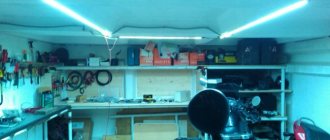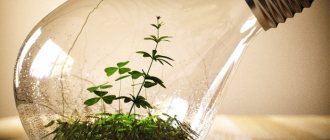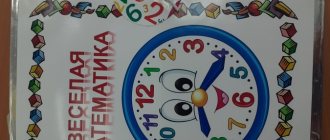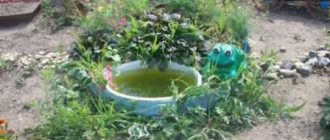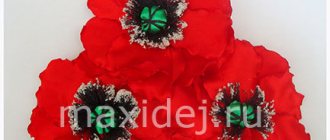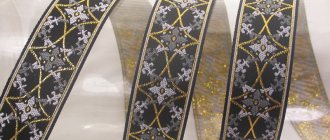Color music or simply lighting with an unusual color is an interesting solution that can be useful in the design of any room. It is quite difficult to find bright light bulbs on the market and in stores, so the only way out is to create colored light bulbs yourself.
Conventional painting options may not be suitable for imparting color to a light bulb, since it will burn the applied layer due to heating. Therefore, for work it is recommended to choose energy-saving LED lamps or 25-watt incandescent lamps. When working on a light bulb, you must remember that the color and brightness of the glow will depend on the density of the color coating.
Using different dyes, coating intensity and the methods described below, you can create a rich collection of different light bulbs with an interesting glow in a few minutes.
Coloring with paste
To color your pen blue, you can use paste from a ballpoint pen. To paint the lamp in the color of the selected paste, you will need to carefully remove the tip and blow the ink onto a sheet of paper or oilcloth. Then, holding the light bulb by the base, rub it with the leaked contents of the pen. You can control the intensity of the coating using acetone, cologne or alcohol.
Why is this necessary?
But in fact, why would a person of sound mind and good memory paint lamps?
The list of possible reasons is quite impressive.
- The most obvious motive is the fight against theft . Everyone is familiar with the problem of dark entrances. The cause of darkness in most cases is theft of a lamp. Painted in any color, it will become unsuitable for sale on the market or for lighting an apartment.
- The construction of color music is another case when it is impossible to do without colored light sources. A reasonable minimum is three lamps of different colors.
Captain Obviousness suggests: in this case, instead of colored lamps, you can use color film filters.
- All kinds of lighting systems for instrument panels and dials with a colored light source look much more impressive.
Why not just get random colored lamps? Do you often see them in hardware stores? Where they are, their price differs from ordinary white ones by 2–3 times.
Colored light bulbs are rare and quite expensive exotics.
Problems
There is only one problem with painting light sources - their temperature. Let's give some values.
| Type | Surface temperature |
| Incandescent lamp, 25 watt | 100С |
| Incandescent lamp, 40 watt | 150С |
| Incandescent lamp, 75 watt | 250С |
| Halogen, 275 watts | 550 C |
| Energy saving (compact fluorescent) | 100С |
| LED | 35 – 50С |
It is clear that dyes not intended for high temperatures will quickly fade in such conditions; a layer of paint will remain transparent for only a few minutes. Compact fluorescent and LED lamps, however, heat up very moderately.
The plastic diffuser of the LED light bulb hardly heats up. Only the power converter gets noticeably warm.
Please note: halogen light sources cannot be painted. At all. A decrease in the transparency of the bulb will lead to its increased and, more importantly, uneven heating, which will inevitably lead to failure.
Method 2 - Nail polish
For this method we will use quick-drying nail polish. It can be used to color a low-power incandescent light bulb or an energy-saving one (fluorescent or LED).
Step-by-step instruction.
- We take a light bulb and, using the brush that is in the varnish, apply the varnish.
- Place on the stand for 10-15 minutes, base down.
- Reapply varnish.
Important! For application, you can use a swab or cotton pad. There will be no streaks and the varnish goes on smoother.
If you only have colorless varnish, don’t worry - you can paint it using ball paste using the method described above.
Features of the painting object and working with it
When switched on, the bulbs heat up quickly and cool down when switched off. The degree of heating depends on the design and type of lamp. This circumstance must be taken into account when choosing a material for painting. The dye must withstand sudden temperature fluctuations and many hours of exposure to heat.
Requirements for such paints:
- high heat resistance (withstands high temperatures and sudden changes that occur when the lamp is turned on and off);
- abrasion resistance (does not crumble when touched);
- safety (does not release toxic or strong-smelling substances when heated);
- transparency (does not interfere with outgoing light).
Method 5 - Stained glass paints
These are special paints for creating designs on glass. They come in different types. In our case, we need water-soluble ones for firing. When heated, they do not burn, but on the contrary, they become more transparent. Accordingly, a light bulb painted using this method will last longer and the coloring will be brighter.
Important! The only drawback of this product is the price.
The application technology is also not complicated:
- Mix the paint in the bottle.
- Apply with a brush or padding pad.
- Dry.
Which means are not suitable?
Not all dyes are suitable for coloring a simple light bulb. The complete list of products that cannot be used for coloring depends on the specific purposes. To obtain the most attractive decorative result, it is necessary to use stable, heat-resistant stained glass paints, silicone or tsaponlac. To quickly create an anti-vandal lamp, paste from a pen is suitable.
Zelenka
Almost every person has a solution of brilliant green in their first aid kit. It is not recommended to use it for coloring, since it is not resistant to high temperatures, wears off quickly and does not allow for uniform darkening. When applied in a thick layer, the brilliant green darkens the glass too much, which is why the lamp ceases to fulfill its main task - illuminating the room.
Markers and felt-tip pens
It is extremely difficult to paint the entire surface of the glass with felt-tip pens and markers. In addition, they are extremely easy to wipe off the surface after application. Even alcohol-based markers can be removed from glass at the slightest touch. That is why coloring with felt-tip pens is not done when working with any lamps.
Expert opinion
Zakharova Irina Yurievna
Cleaning professional with 15 years of experience. Our best expert.
Ask a Question
Even if you manage to paint the glass with a marker, the product will greatly lose its brightness and will be unsuitable for lighting or creating light music.
How to calculate the optimal parameters of a phytolamp for 2 types of structures
Let’s immediately differentiate the tasks of the lamp. It can be used for:
- additional lighting, when seedlings develop on a windowsill, in a greenhouse, in a winter garden and receive the full portion of daylight, and at dusk they are illuminated with a useful spectrum of bicolor lamps (two colors - red and blue);
- or constant lighting (light culture mode).
In the second case, at the beginning of the growing season, bicolor lamps are used, and further growth is carried out on multispectrum sources (full spectrum). This option involves the development of plants in isolated compartments (grow boxes and grow tents) away from the window.
Let’s skip it now and focus on the first task.
When solving it, we first need to determine the amount of energy required for photosynthesis (watts per square meter), and use it to select phytolamps, which are estimated by the consumption of electrical power in watts, accompanied by increased energy losses.
In greenhouses with large planting areas, sodium arc lamps of tubular designs DNaT, DNaZ (with a mirror reflector) and DriZ (mercury metal halide, mirror), as well as luminescent sources, are widely used to illuminate plants.
Based on the experience of their use, standards for the minimum level of illumination for plants have been developed: 6-7 kilolux (klx). During the winter and early spring they are increased.
In this case, it is necessary to achieve a specific lighting power of 50-100 watts per square meter. It is provided by changing the distance from the lamp to the seedlings.
For sources with a power of 1000 watts, the light is referred to 80-100 centimeters, 600 - 60÷80, and 400 - 40÷60 cm. The guaranteed crop is grown at 10÷12 klx, but not more than 20.
Online plant lighting calculator
This accessible method is designed to facilitate the calculation of lighting fixture parameters. Use it.
Online calculator (link will open in a new window)
About the benefits of a reflector
The use of a screen allows for targeted distribution of light flux with maximum benefit for plants. The best reflectors are mirrors and aluminum foil.
Even the simple placement of cups with seedlings on foil allows you to improve its illumination from below due to the reflection effect at any time.
How to calculate the number of lamps: a simple method
We know the area that the seedlings will occupy and the lighting area from one lamp.
According to these data, it will be necessary to place the circles from all the lamps in such a way that they completely cover the plants without any gaps, providing their entire area with constant lighting.
This graphical method allows you to get rid of complex mathematical formulas.
7 stages of lighting system calculation
A brief algorithm for creating a lighting project is as follows:
- Determine the required level of illumination in watts of PAR per 1 square meter of area.
- Find out the dimensions of the area that needs lighting.
- Calculate the illumination values of the area occupied by plants.
- Determine the number of watts of phased array that the source should provide.
- Calculate the lamp power to provide optimal photosynthetically active radiation.
- Determine the required number of lamps.
- Draw up lamp placement diagrams.
Can I use brilliant green, marker, gouache, felt-tip pen?
Zelenka is actually an aniline dye dissolved in alcohol or water. Despite its rich emerald color, it is not suitable for tinting glass. The brilliant green is too liquid to stick to a smooth surface. An alcohol marker or felt-tip pen is suitable for applying drawings and signatures to the lamp, but with their help it is difficult to achieve a uniform background.
The option with gouache is acceptable only in cases where the light bulb does not have to be touched with your hands. Dried gouache gives a beautiful and bright color, but it wears off when you touch the surface it painted. If you want to paint a lamp with gouache, you should first screw it into the socket and only then cover it with paint.
How to paint an LED lamp
The method of painting an LED lamp depends on the type of its surface. Because this type of product generates less heat, more coloring agents are available. Even those dyes that can withstand only slight heating up to 100 degrees C are suitable. The main parameter that you need to pay attention to when selecting paint is its transparency and adhesion to glass. To preserve the brightness of the product to the maximum, both ballpoint pen paste and tsaponlak are suitable. There is no need to use expensive heat-resistant stained glass paint.
How to paint
To change the color of a light bulb and then use it as before, you need to pay attention to the choice of dye. Regular paint is not suitable for this, since immediately after heating it will begin to melt, dry out, crack and deteriorate. The consequences of using regular paint can be dangerous. To choose a pigment, you should consider what color you want the light bulb to be. This way you will select a composition that will evenly cover the glass, preventing damage to the result.
Nail polish
Nail polish is often used to color light bulbs. The main advantage of the compositions is the number of shades. You can even paint the lighting fixture green, or create a smooth gradient of shades, which will allow you to decorate your apartment. There are other positive aspects of using varnishes:
- Good adhesion. It is tightly applied to the surface, preventing the formation of smudges, chips, and cracks when heated;
- Withstands heating up to two hundred degrees Celsius;
- When applied in a dense layer, it looks evenly and does not form unevenness on the surface, which is then reflected in the emitted light.
How to make a DIY phytolamp for plants from LEDs - detailed instructions
Growing seedlings at home is greatly improved by homemade structures.
To make them you will need to purchase:
- LEDs in the required quantity with certain light characteristics;
- power source: driver or power supply;
- a base for their fastening, which simultaneously serves as a cooling radiator;
- connecting wires.
Which LEDs to choose for lighting seedlings
The range of LED diodes is quite large. Based on your budget, you can purchase:
- modules specially designed for use in phytolamps (Full Spectrum Led). Their design is easy to install, has the ability to regulate the radiation strength and spectrum frequency, but is expensive;
- powerful high-brightness diodes of a certain color, belonging to the middle price category. They will need to be mounted on cooling radiators;
- low-power LEDs, which will have to be installed tightly and in large quantities, which will greatly complicate installation and the overall design.
The number of LEDs and their location will need to be calculated to provide optimal PAR for seedling growth, based on a distance of 25÷40 cm.
Features of choosing a power plan
The light characteristics of an Led module strongly depend on the amount of current flowing through it and require stabilization of the input parameters.
At the same time, the color spectrum and brightness of the glow must be adjusted during different periods of the growing season. Drivers for phytolamps have such capabilities.
They allow you to pass a stable current through the diodes for a long time and, if necessary, adjust its value.
A more economical solution is to use simple power supplies that do a satisfactory job of stabilizing the light flux. And to change colors you will have to use an additional block, fortunately it is not difficult to do it yourself.
When choosing a driver or power supplies, it is important to meet the following conditions:
- Usually the ratio of blue and red colors has to be selected in a ratio of 1:2. It must be preserved at power sources;
- The power of the driver or power supply must have a reserve and exceed the load of the ice diodes by 20% in maximum operating mode.
How to make a case with a radiator system
Various metal structures can be used as a frame for placing diodes:
- special aluminum profiles with cooling fins;
- a tin frame from the cover of an old fluorescent lamp;
- aluminum profile or corner;
- other similar parts and available materials.
The dimensions of the housing are selected according to the dimensions of the illuminated area with seedlings. Aluminum U-shaped channels are popular among DIYers.
They allow you to create effective natural cooling by placing LEDs on the middle part with the direction of their light downward, and the sides are oriented upward to dissipate the temperature into the environment.
If you join two such profiles sideways, the W-shape will allow you to create two rows of lamps at once. To protect them from mechanical loads, it is enough to mount restrictive wire loops from below, which will simultaneously serve as the legs of the stand.
Immediately consider a way to hang the phytolamp and adjust its height above the seedlings. It is easier to set this up on a metal frame before mounting and soldering the circuit elements.
For safety reasons, prevent people from touching the radiator when the power is on. It may have dangerous potential.
LED installation sequence
Each LED module needs:
- check for serviceability;
- secure permanently to the planned location of the body;
- connect to the power circuit:
- check in operation.
How to check if an LED is working properly
The integrity of a semiconductor junction is assessed by any multimeter or tester. It is enough to switch it to the dialing or ohmmeter mode. With one polarity of connecting the probes, it will open and let the current pass, and with the other, it will block its passage.
When there is no current or it flows in both directions, this is a clear sign of damage.
The diode test mode on some multimeter models allows you to measure the opening voltage of a semiconductor junction.
For multi-color diodes, it is necessary to separately evaluate the health of the circuit of each spectrum.
It is more convenient to test a large number of LEDs with a DC voltage source with an additional resistor, for example, a battery with a light bulb. Just first limit the load across the semiconductor junction so as not to burn it.
Methods for installing LEDs on a profile
Powerful and bright semiconductors are mounted directly on an aluminum radiator to improve heat removal from them. They are immediately oriented taking into account polarity, which will facilitate further installation and simplify soldering of wires.
Modules equipped with holes for fastening are secured with screws or self-tapping screws. To do this, they need to be marked on the radiator using a template and holes drilled.
We take into account that thermal paste improves heat removal from the semiconductor. We apply it to contact surfaces.
An alternative to this method is hot-melt adhesive, which is applied around the perimeter of the diode, and a thin layer of thermal paste is pre-coated in the center.
The surfaces to be bonded must be degreased in advance.
2 diode connection diagrams
All semiconductors are connected in series to the current source in an amount depending on its electrical characteristics. In parallel, a chain of current-limiting resistor is assembled.
Its denomination is not difficult to calculate using the formulas of an electrician’s cheat sheet.
If necessary, chains of such LEDs and resistors can be combined and powered in a parallel circuit from one powerful source.
Safe soldering methods
The semiconductor junction is easy to overheat and damage. Therefore, soldering should be done carefully with a soldering iron with a power of up to 25 watts.
Ordinary lead-tin solder is suitable for connections, and rosin is quite suitable as a flux.
Do not use acids; they will destroy the electrical contact over time.
For forced cooling, you can install a cooler at the back and additionally connect it to the same or a separate power supply.
How photosynthesis affects plant development: briefly
During the process of photosynthesis, carbohydrates are formed from inorganic substances under the influence of solar radiation energy. Organic cells are formed from them.
The process proceeds according to the chemical formula with sequential alternation of two phases:
- light, when oxygen and hydrogen are released from water;
- dark - carbon dioxide is absorbed to form carbohydrates.
Plants need both phases for their development, but the spectrum of natural sunlight in winter is very short.
Therefore, when growing seedlings, additional illumination from artificial sources has a beneficial effect on its development.
It is important to realize that the radiation spectrum and its power must be selected optimally, because modern electric lamps are created in a large assortment with different technical characteristics.
Their parameters should be carefully analyzed for all stages of seedling development, and the influence of the spectrum should be taken into account.
| Lamp color | Impact on growth and development |
| Red | Accelerates the development of seeds, the formation of sprouts, improves flowering, and promotes the formation of ovaries. |
| Orange | Provides better fruiting. |
| Yellow and Green | They influence growth. |
| Purple and Blue | Stimulates root development and accelerates the flowering phase |
| Ultraviolet | In small quantities it limits overgrowth, but in higher doses it causes burns to leaves and stems. |
Solutions
Paste
How to paint a light bulb blue? The simplest solution is to use ballpoint pen paste.
How to do it?
- We take out the tip with the ball from the rod.
- Blow the contents of the rod onto a sheet of paper.
- Holding the light bulb by the base, rub the bulb with paste.
In the Youth Technology magazines 30 years ago, one could find an advanced painting method: the paste was diluted in acetone and applied to the flask with a brush. In this case, it is easier to control the color saturation; however, liquid dye is quite difficult to apply to a smooth glass surface.
As a solvent for paste, you can use not only acetone, but also ethyl alcohol or cologne.
Nail polish
Quick-drying nail polish can be used as paint if you are going to paint a low-wattage incandescent lamp or one of the economy light bulbs (fluorescent or LED). Unfortunately, it burns out at temperatures above 200 degrees. It’s easy to apply the varnish using the brush or cotton swab that comes with the tube.
Long-lasting translucent nail polish is quite suitable for our purposes.
Do you only have clear varnish at your disposal? No problem: the same ballpoint pen paste will help color it.
Colored PVA glue can also be applied to moderately hot light sources. Inkjet printer ink or any water-soluble pigments can be used as a dye. When dry, the white glue becomes transparent.
Auto enamel
Instructions that may be useful to car enthusiasts: car enamels sold in aerosol cans are also suitable for light bulbs with a bulb temperature of up to 200 degrees. It is better to spray the enamel from a distance of at least 30-40 centimeters: too thick a layer of paint can make the flask opaque.
Stained glass paints
Dyes intended for creating stained glass are ideal for our purposes. But not all: we need water-soluble paints for firing. When heated, they do not burn, but, on the contrary, become more durable.
The disadvantage of the solution is the rather high cost of the dyes: a 50-gram tube costs 150 - 200 rubles.
Organosilicon
Organosilicon paints are intended specifically for painting surfaces operating at high temperatures. The upper limit of the operating range reaches 600 degrees, which allows you to avoid the risk of burnout even with the hottest light sources.
A caveat: for the coating to be transparent, the enamel will have to be thinned. The type of thinner is always indicated on the packaging; Thus, for domestic KO-813, you can use solvent No. 646, xylene or solvent.
The photo shows silicone enamel KO-813.
Tsaponlak
Finally, for painting you can use tsaponlak, which is easy to find in radio parts stores. Its main function is to protect traces and soldering on boards from short circuits. (See also the article Gloss paint: features.)
What does it contain?
- Nitrocellulose.
- Solvent (usually acetone).
- An optional organic dye allows the use of varnish for color marking of connections and parts.
Since the operating temperature of key transistors in power converters can reach 150 degrees, the tsaponlak used to insulate their terminals, willy-nilly, must be heat-resistant.
The only drawback of tsaponlak is the limited choice of colors in most stores. How to paint a light bulb red if you only have clear varnish?
It’s easy to give it the desired color with your own hands; The method is already familiar to us:
- We open the refill of a ballpoint pen with red paste.
- Blow the paste into a bottle of varnish.
- Mix thoroughly.
- We apply.
Tsaponlak is painted in the desired color using a ballpoint pen.
Tsaponlak
You can purchase this coating at a store specializing in radio components. The main function of the coating is to protect tracks and soldering from short circuits. Since the operating temperature of transistors reaches 150 degrees, the product is also suitable for coating light bulbs.
These are the simplest and most affordable ways to coat a rather capricious material - glass. The choice is narrowed several times if the question concerns light bulbs that burn often and for a long time, because not all dyes can withstand high temperatures.
The lighting of a room creates its atmosphere and regulates the emotional mood of its owners and guests. This way you can create a work room, or vice versa, a relaxation area. To decorate a space, lighting of different colors is often used, but its price is much higher than the price of standard lighting fixtures. Because of this, you need to learn how to paint the light bulb yourself.
Installing a new light bulb
After the burnt element is unscrewed, you need to insert the light bulb correctly to ensure its secure fastening and long-term operation. There are no particular difficulties here, just follow a few tips:
- Check the condition of the thread and the absence of carbon deposits on it if the base had to be torn off. If there is damage or dents, it is better to replace the outer part of the cartridge; it can be purchased assembled.
- Be sure to bend the contact on the inside so that it presses well against the base. You just need to pull it a little towards yourself, since over time the spring steel loses its elasticity and the contact deteriorates, which often leads to the bulb burning out.
- First, screw the outer part of the cartridge until it stops; it should not dangle. Then carefully screw in the light bulb clockwise. If it does not fit in easily, gently wiggle it or unscrew it a little and screw it in again, do not apply force.
After screwing in, be sure to check the operation of the light bulb.
After finishing work, turn on the power supply and check the operation of the light bulb. If everything is in order, you can remove the tools and accessories.
Method 6 - Organosilicon
The painted surface with silicone enamel can withstand high temperatures. Light bulbs painted this way can be used to create color music. Can be purchased at any hardware store.
Important! When purchasing, pay attention to the toxicity of the varnish.
Instructions for use:
- Mix the enamel with the solvent (the brand of the required solvent is written on the package).
- Apply to the light bulb using a brush.
- Place on a rack to dry.
Important! Wear a mask and gloves while working, as the paint is toxic during drying and painting.
